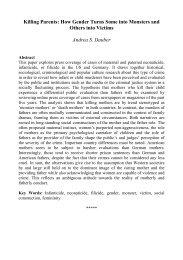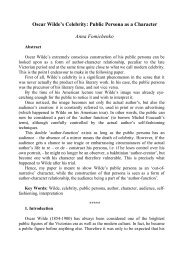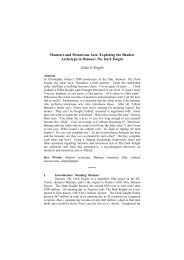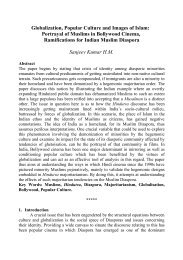The 'green-eyed monster': jealousy and erotic monomania in He ...
The 'green-eyed monster': jealousy and erotic monomania in He ...
The 'green-eyed monster': jealousy and erotic monomania in He ...
Create successful ePaper yourself
Turn your PDF publications into a flip-book with our unique Google optimized e-Paper software.
novelists to Woolf, <strong>and</strong> writes that ‘Woolf’s depiction of fem<strong>in</strong><strong>in</strong>ity resonates with the depictions of<br />
Gaskell <strong>and</strong> Oliphant as she simultaneously re<strong>in</strong>vents the novel <strong>and</strong> revises the marriage plot.’ 6 Mary<br />
Poovey places this narrative shift earlier, with Thomas Hardy’s 1890s fiction, tak<strong>in</strong>g ‘as its subject<br />
marital unhapp<strong>in</strong>ess as well as bliss.’ This paper, however, will argue for its appearance earlier still, <strong>in</strong><br />
the 1860s.<br />
In <strong>The</strong> Forsyte Saga, Galsworthy makes a shock<strong>in</strong>gly frank contribution to debates about marriage<br />
based on servitude <strong>and</strong> mastery. Yet more controversially, Galsworthy exposes the tragedy of madness<br />
fuelled by sexual desire with ‘a man enslaved by his own possessive <strong>in</strong>st<strong>in</strong>ct, who couldn't see the sky<br />
for it, or even enter fully <strong>in</strong>to what another person felt!’ 7 By 1906 Galsworthy could portray marital<br />
rape: an act which I argue underlies concerns about marriage <strong>and</strong> a wife’s <strong>in</strong>dependence <strong>in</strong> earlier<br />
fiction. Just fifteen years before the publication of this section of the saga, Hardy’s Tess of the<br />
D’Urbervilles sc<strong>and</strong>alised readers with its portrayal of the raped woman as a morally pure victim.<br />
Galsworthy’s Irene is similarly <strong>in</strong>nocent of all blame for the violence she experiences. Despite its early<br />
date, Trollope’s novel also subverts normative treatments of marriage <strong>in</strong> Victorian fiction, present<strong>in</strong>g<br />
<strong>monomania</strong> fuelled rather than cured by marriage.<br />
Follow<strong>in</strong>g the fem<strong>in</strong>ist tradition, the failed-marriage plot is widely understood as concerned<br />
‘primarily with the matter of female agency: it tends to revolve around a wife leav<strong>in</strong>g her husb<strong>and</strong>.’ 8<br />
However, this view is predicated on the assumption that only female agency is restricted <strong>and</strong><br />
problematized by n<strong>in</strong>eteenth-century marriage laws. I suggest that Trollope frames the failed-marriage<br />
plot primarily as a man’s plot. James Eli Adams has expla<strong>in</strong>ed the critical shy<strong>in</strong>g away from<br />
mascul<strong>in</strong>ity studies, writ<strong>in</strong>g that it ‘has been resisted by those concerned that dwell<strong>in</strong>g on the<br />
complexities <strong>and</strong> burdens of mascul<strong>in</strong>e identity would serve to obscure, <strong>and</strong> thereby to re<strong>in</strong>force, the<br />
brute realities of male dom<strong>in</strong>ation aga<strong>in</strong>st which fem<strong>in</strong>ist analyses were <strong>and</strong> are <strong>in</strong> the first place<br />
directed.’ 9 Such studies also risk fall<strong>in</strong>g <strong>in</strong>to what Eve Kosofsky Sedgwick terms a ‘vast national wash

















